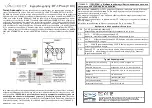
Glossary
Summit WM20 User Guide, Software Release 4.2
232
T
TCP / IP
Transmission Control Protocol. TCP, together with IP (Internet
Protocol), is the basic communication language or protocol of the
Internet. Transmission Control Protocol manages the assembling of a
message or file into smaller packets that are transmitted over the
Internet and received by a TCP layer that reassembles the packets into
the original message. Internet Protocol handles the address part of
each packet so that it gets to the right destination.
TCP/IP uses the client/server model of communication in which a
computer user (a client) requests and is provided a service (such as
sending a Web page) by another computer (a server) in the network.
TFTP
Trivial File Transfer Protocol. An Internet software utility for
transferring files that is simpler to use than the File Transfer Protocol
(FTP) but less capable. It is used where user authentication and
directory visibility are not required. TFTP uses the User Datagram
Protocol (UDP) rather than the Transmission Control Protocol (TCP).
TFTP is described formally in Request for Comments (RFC) 1350.
TKIP
Temporal Key Integrity Protocol (TKIP) is an enhancement to the WEP
encryption technique that uses a set of algorithms that rotates the
session keys. TKIPs’ enhanced encryption includes a per-packet key
mixing function, a message integrity check (MIC), an extended
initialization vector (IV) with sequencing rules, and a re-keying
mechanism. The encryption keys are changed (rekeyed) automatically
and authenticated between devices after the rekey interval (either a
specified period of time, or after a specified number of packets has
been transmitted).
TLS
Transport Layer Security. (
See
EAP, Extensible Authentication
Protocol)
ToS / DSCP
ToS (Type of Service) / DSCP (Diffserv Codepoint). The ToS/DSCP
box contained in the IP header of a frame is used by applications to
indicate the priority and Quality of Service (QoS) for each frame. The
level of service is determined by a set of service parameters which
provide a three way trade-off between low-delay, high-reliability, and
high-throughput. The use of service parameters may increase the cost
of service.
TSN
Transition Security Network. A subset of Robust Security Network
(RSN), which provides an enhanced security solution for legacy
hardware. The Wi-Fi Alliance has adopted a solution called Wireless
Protected Access (WPA), based on TSN. RSN and TSN both specify
IEEE 802.1x authentication with Extensible Authentication Protocol
(EAP).
Tunnelling
Tunnelling (or encapsulation) is a technology that enables one
network to send its data via another network's connections.
Tunnelling works by encapsulating packets of a network protocol
within packets carried by the second network. The receiving device
then decapsulates the packets and forwards them in their original
format.
Summary of Contents for Summit WM20
Page 8: ...Table of Contents Summit WM20 User Guide Software Release 4 2 8 ...
Page 20: ...About this Guide Summit WM20 User Guide Software Release 4 2 20 ...
Page 54: ...Configuring the Summit WM Controller Summit WM20 User Guide Software Release 4 2 54 ...
Page 96: ...WM Access Domain Services Summit WM20 User Guide Software Release 4 2 96 ...
Page 150: ...WM Access Domain Services Configuration Summit WM20 User Guide Software Release 4 2 150 ...
Page 168: ...Availability and Controller Functionality Summit WM20 User Guide Software Release 4 2 168 ...
Page 172: ...Working With Third Party APs Summit WM20 User Guide Software Release 4 2 172 ...
Page 184: ...Working With the Summit WM Series Spy Summit WM20 User Guide Software Release 4 2 184 ...
Page 194: ...Working With Reports and Displays Summit WM20 User Guide Software Release 4 2 194 ...
Page 216: ...Performing System Maintenance Summit WM20 User Guide Software Release 4 2 216 ...
















































